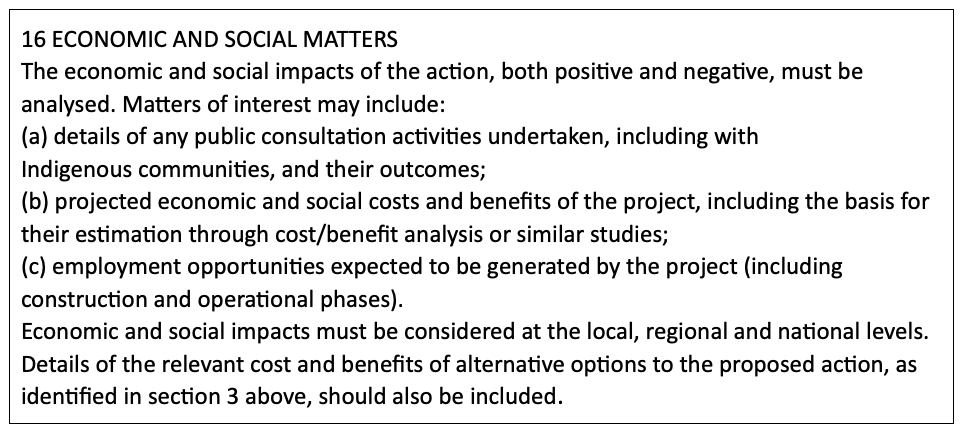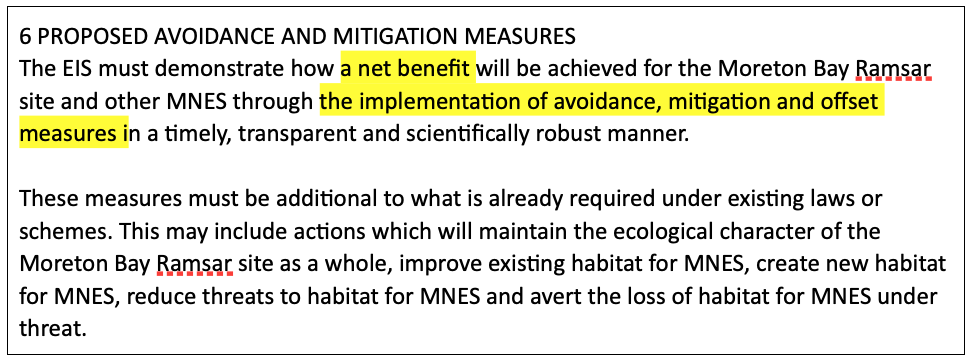
The Guidelines set by the Federal Government for the Environmental Impact Study (EIS) of the proposed Toondah Harbour development include economic and social matters which will require some cost-benefit analysis.
Requirements for cost-benefit analysis in the Toondah EIS
The relevant clause from the EIS Guidelines is:

This does not, or at least should not, make economics the only or even the main grounds for deciding whether the Toondah development should proceed.
Clause 16 of the guidelines requires a cost-benefit analysis and information on ‘employment opportunities’. An earlier article for Redlands2030 explains cost-benefit analysis and some of the issues in applying the technique to the Toondah development proposal. This article examines how the developer might be able to use the analysis to claim that the public benefit from the project will outweigh environmental damage and provide substantial offsets that actually leave the place ‘better
The scope of cost-benefit analysis
The economic and social analysis must consider ‘relevant cost and benefits of alternative options as identified in section 3’. The latter states

MNES as used above is ‘matters of national environmental significance’; that is those environmental matters covered by Federal legislation. These include RAMSAR wetlands, nationally threatened species and ecological communities and migratory species.
The cardinal issue of ‘benefit’
The term benefit is also used in clause 6 of the guidelines;

The critical clause is ‘how a net benefit will be achieved for the Moreton Bay Ramsar site’. This is to be sought through some combination of the development and avoidance, mitigation and offset measures that will make the ‘environment’ of Toondah ‘better’ than leaving things as they are.
Put plainly and from the developer’s viewpoint, the bigger the benefits that can be found in the project, the easier it will be to show funding is available for offsets and the harder it will be for critics to fault the project.
Most supporters of Redlands2030 find it difficult to conceive of much positive about the proposed development. However, it seems quite likely that creative minds and consultancy fees will be able to conjure ‘better futures’ in which 3,500 residential units and a marina commingle with ‘improved’ wetlands and more contented migratory birds.
There is a strong conventional wisdom that the EIS process whether Federal or State is essentially about negotiating offsets. The science, the economics and the rest are in most cases merely the means to putting a price for going ahead with ‘development’.
Assessing benefits
The assessment of benefits is one of the most decisive parts of the entire EIS process since the ‘outcome’ depends on which aspects of the development are included and how impacts are measured. Take the example of fish habitat. The Toondah project involves clearing mangroves, excavating a marina and building out into the Bay all of which will affect fish habitat.
The analysis requires a science-base to establish what effects will occur and to quantify them. This needs to be as basic as how much fish habitat will be lost and what will this mean for the various species of fish that are in the habitat. Then the changes need to be valued (for cost-benefit analysis given a $ value); this is relatively straightforward if there is loss of commercial catch; for recreational fishing the measurement might be reduction in the number and frequency of fishing trips to Toondah and some ‘shadow pricing’ of what recreational fishers people think this loss has cost them.
There is plenty of room for argument – how much habitat is lost, how are the fish affected; how many people will stop or reduce their fishing; how much is this worth to them.
And, as if that is not enough, the developers may well claim that there will be improvements in the fishing – indeed some of the Walker Group advertisements say it will be “A fishing paradise…” and “A new marina will promote habitat diversity and help attract more fish”.
Economics and offsets
The ‘Get Hooked’ ad is part of recent promotion of Toondah that seems to be more about making a new coastal amenity and playground than a residential development. This would fit with an effort by the Walker Group and their supporters to use the EIS to demonstrate that the project will have such a high net benefit for the community that an extensive set of offsets can be afforded that will substantially out-weigh the assessed losses of wetlands, bird habitat and fish breeding grounds.
Strengths and dangers of cost-benefit analysis
Cost-benefit analysis is mainly used for infrastructure or social projects (eg a bridge, road, power station, school, hospital) where there is a relatively finite ‘product’ or ‘service’ flowing to users over time. Examples are lower journey time, better health/reduced health costs, reduced long-run maintenance, income from new assets that can be valued against the initial and continuing costs including construction and capital costs, damage to amenities and ecological impact.
Toondah seems more of a speculative property project with a limited stream of benefits except in regard to the marina and commercial spaces. The construction costs (materials and labour) of the 3,600 units will create a capital stock not an income generating asset. The construction costs for Toondah units (just like those anywhere else) will be met by purchasers most of whom will raising mortgages paid off over time. It is effectively one finance house lending the construction costs to the developer and another lending money to purchasers to enable the developer to pay off their debts and liquidate a profit.
The most likely danger
As discussed above the project looks as if it is being presented as the creation of a new coastal amenity – a Toondah pleasure park with some improved marine services. In which case expect big claims (and associated numbers) that the project will increase tourist numbers to Minjerribah – it would be easy to claim a 10 per cent increase on the current 350,000 trips per year and median spend per trip of $810 (UQ Visitor Research 2018) giving an additional annual revenue of $28.4 m.
Expect a second claim to include a value for the new coastal park. For example doing a ‘shadow price’ that people would pay to go there (say $20 per visit) and estimating frequency by some kind of survey. Thus 4 visits per year per RCC resident (160,000 pop (2020 estimate) at a shadow price of $20 ) is $12.8 m.
Taken together these would give some $40m that the developer can claim to put towards justifying offsets for the damage to wetlands. These numbers might be as implausible as the traffic forecasts for the Clem7 and Airport Link tunnels which were many multiples of the actual patronage. Yet we need to get ready to answer such big numbers and to argue that they do not mean ‘a better Bay for birds and people’. We need to expect more moonshine than illumination from the EIS.
Written by:
Howard Guille
Minjerribah
Redlands2030 – 19 July 2021
Please note: Offensive or off-topic comments will be deleted. If offended by any published comment please email thereporter@redlands2030.net
4 Comments
High rise towers out in the (at present) Bay is a potential future disaster for the rate payers of redland city who are now responsible for canal revetment walls as they fail after 20 odd years.
IMAGINE the rate payers stress when the(at present 10 story structures) suffer structural problems ,and don’t think it won’t happen, look to hirise structures in Sydney in the last few years ,evacuations as the structures crack and these not built in a bay situation.
I should add that at 80 plus y o This will not be a bill for me
Cannot wait for Toondah Harbour development to get up, is it true each high rise will only be 10 stories, can you help us lobby for 30 stories lets get real like Roma St Development; Hamilton Harbour etc.
Your readers are all house and land people with native animal-eating dogs , some of us love high rises as the growing population in Redlands shows Bring it on!
Any job-creation benefit claimed for a project of this kind is a fiction. Because if a finance house is willing to lend money to this developer at this site, presumably it would be willing to lend a similar quantum of money for a less contentious project at a different site. In other words, development projects steer employment to a given location, they tend not to create them. Investment capital is footloose.
There is no cost benefit for the environment, it is all negative from the already suffering Narita and Cone shell molluscs that live on the shore to the fish, dugons and koalas in the trees. There is no cost benefit for the shore birds and no cost benefit for me as I will lose an open breathing space and a view of the bay.